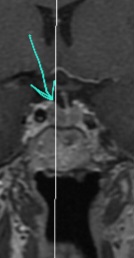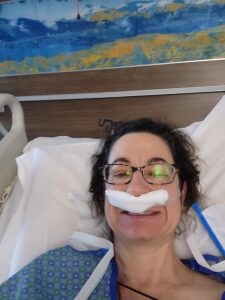I am back! I’ve been on a hiatus while dealing with my Cushing’s Disease. It’s been a wild ride. I was finally diagnosed with Cushing’s Disease and had pituitary surgery to remove my tumor. The pituitary is often called the master gland because it regulates so many of our body’s functions like our thyroid function, growth hormone, sex hormones, adrenal hormones, plus others. The pituitary measures about ½ of an inch in size and is located at the base of the brain in line with the nose. Cushing’s Disease is caused by a pituitary tumor that makes ACTH, adrenocorticotropic hormone, which stimulates the adrenal glands to produce too much cortisol which is a stress response hormone. Cortisol also affects your blood sugar, immune function, inflammation, blood pressure, metabolism, muscle integrity, among other things.

In March, I blogged about my Cushing’s Syndrome which was causing serious health issues, but the source of my excess cortisol was not yet confirmed. I was officially diagnosed in April after some invasive confirmatory testing with an IPSS. During an IPSS, an interventional radiologist accesses the venous system through the femoral veins in the groin on both sides of the body and advances catheters up to the veins in the petrosal sinuses near the pituitary gland to measure ACTH levels coming from the right and left pituitary gland. My IPSS showed 40 times normal ACTH coming from the right pituitary gland.
In May, I had transnasal transsphenoidal surgery to remove my pituitary tumor. During transsphenoidal surgery, the neurosurgeon gets to the pituitary gland by going through the nasal passages to the sphenoidal sinuses and removing part of the skull to access the pituitary gland. After this type of surgery, it’s routine to go to the Neuro Intensive Care Unit (ICU) for close monitoring. With Cushing’s Disease, there is extra monitoring done with blood cortisol levels because levels should drop if a tumor has been successfully removed. Once levels are super low, one gets started on steroids like prednisone or hydrocortisone to prevent adrenal insufficiency, which is life threatening. Ironically, the body goes from making too much cortisol to zero cortisol production after removal of the tumor because the rest of the normal ACTH-producing cells in the pituitary gland are still dormant—they stopped functioning due to too high levels of ACTH made by the tumor cells. It can take up to a year-and-a-half for the pituitary function to return.
Recovery from the surgical procedure has not been that bad. I still have sinus congestion which is why I sound like I have a mild cold when I talk. I am back to exercising and using straws and blowing my nose which are some things you can’t do after pituitary surgery. I can sleep through the night now, and my anxiety has resolved. I no longer have crazy sweaty armpits just from drinking a half cup of coffee or driving to the store. I stopped my high blood pressure medication. I am trying to rebuild the muscle I lost, but between Cushing’s Disease and recovery time, I have muscle weakness that makes it difficult to get up from the floor or low seats. For now, I have joint pains, fatigue, and can sleep for 10 hours!

I am grateful my Cushing’s was diagnosed after struggling with symptoms for only a few years. I have heard so many horror stories from other Cushing’s patients who struggled to get a diagnosis and treatment for years, even decades, who struggled to be heard and taken seriously. I heard one person describe it as “the worst disease you’ve never heard of…” which is why I am talking about it in hopes of raising awareness.





